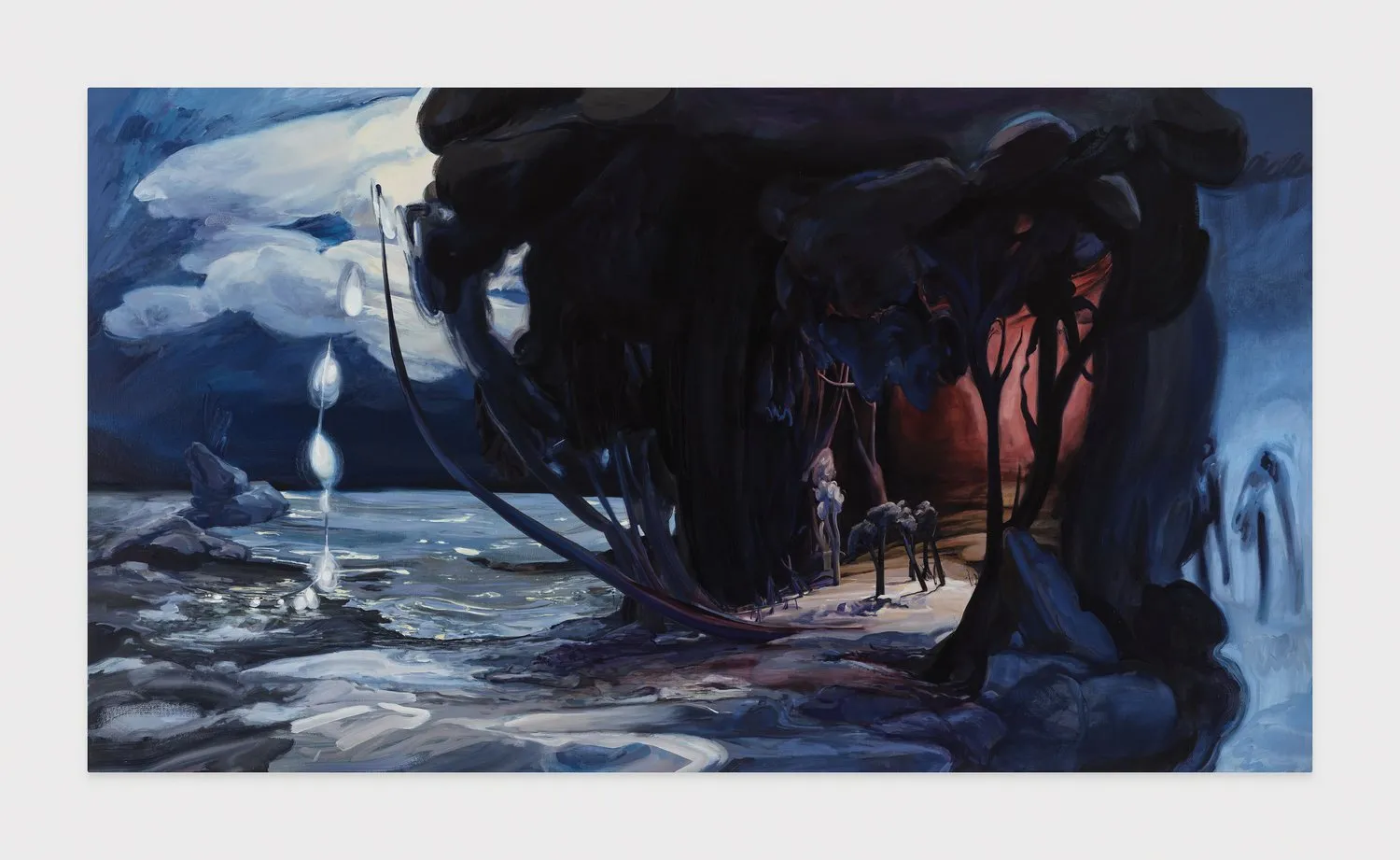F L A U N T


A tree grows slightly sideways, curling around itself, or outward, as if toward a light source just beyond its scope. An open space invites you to crawl inside. A landscape, not unlike one you might see upon stepping into a forest—but unlike any terrain we know—envelopes the onlooker. This unreal scene engenders a sense of wonder and confusion and excitement.
Artist Emma Webster recalls a visit to Los Angeles’ Griffith Observatory, watching kids shriek and run around, hitting the space-exploring dioramas and buttons, visibly excited. The kids are at home in the space, feeling only joy and lacking self-consciousness. “When you go into an art gallery,” Webster reflects, “it’s like everyone’s insecurity shield instantly comes up and we don’t want to talk about it. We don’t want to sound dumb.”
Webster’s forthcoming show, Illuminarium, encourages people to realize there is space for them there, in the gallery. Set to open in conjunction with Frieze Seoul this September, Webster will inaugurate the new gallery outpost of Parisian fixture, Perrotin. The heft of christening a gallery is not lost on the artist. “It felt like a real point of departure,” she shares on the opportunity, “a real big thing.” Since earning her MFA from Yale in 2018, Webster has held solo shows in Los Angeles, London, New York, and Brussels. This marks her first exhibition in Asia.

Webster’s works are made to be populated. Her paintings aren’t merely spectacles for a static, unthinking audience—they ask something of the viewer. While she wants her audience to feel there is space for them in the work, she challenges them to do something with that space they’re given. “So much of art now is like, ‘Amuse me!’” the artist says. “Whereas these are kind of like, ‘Why don’t you do something for yourself?’”
At the same time, the pieces don’t invite one in so much as around. “I struggle with this idea of wanting an immersive experience,” Webster says, “but then not actually wanting to give the viewer too much agency.” This barrier is, in fact, at the core of Webster’s practice. The artist uses VR to create virtual renderings of her scenery before picking up a paintbrush—a point of departure from her old handmade renderings. She describes the shift from an artist manipulating a little ball of clay with her hands to stepping inside the ball of clay, then creating a cage around herself. And she’s the only one to have been inside. “I’ve been in this weird zone,” she says, “Where I’ve realized that I’m the only one who has put the headset on, who has actually crawled into this.” Viewers are left in a space of hybridity, teetering between falsity and reality.
It’s this hybrid space that invites an experience analogous to attending the theater. But instead of watching a performance, viewers are met with a vacant set. “By emptying out the stages, it requires that the audience brings the theatricality,” Webster explains. This theatricality, so potent in the finished products, stems from Webster’s process itself. For the first time, with Illuminarium, the artist lifts the veil on the construction of her evasive works, elaborated upon with the book, Behind the Scenes: Process & Paintings.
The book includes a host of sketches, VR renderings, and oil paintings, illuminating the steps through which her pieces come to be. It’s the first time she’s shared a glimpse into her process, an intervention that Webster worries might ruin her magic trick. But the degree of separation remains. While viewers might now better understand the process, they’ll never be able to immerse themselves to the same extent. We might, for a moment, feel engulfed by the unreal scene in front of us, but then we turn around, and we’re back in the gallery, drawn towards another trippy landscape.

Technology enables us to see things we wouldn’t otherwise be able to see. For instance, Webster can envision the way light might bounce off of an impossibly angled tree. “We can see the effects of pollution on generations through data,” she demonstrates, before asking, in turn, how we can apply these ways of seeing to painting—beyond a stroke of light. Despite its affordances, Webster is wary of the inaction of technology. The tech may produce the renders, but at the end of the day, she’s the one placing brushstrokes on a canvas. “Just because we know the data doesn’t mean we’re actually going to take action and do these measures,” she cautions. “Tech is somehow still in this etherspace. I wish there was a way of making a lot of our discoveries there more tangible.”
While Webster is hesitant to classify all of her paintings of landscapes as climate-related, she also acknowledges the issue’s closeness to her heart. There is a read—though not a singular one—where her work explores environmentalism.“I do think there’s something interesting about using the very tool that we’re using for the environment,” she muses on the agency of VR in both climate studies and the finished artworks, “using that same tool to shape conversations and depictions of the environment.”
In the end, Webster’s paintings don’t submerge viewers into a horror-inducing, ruined planet, despite her somewhat sci-fi leanings. Instead, it might be argued, they offer a place to hide. A promise or refuge and rescue—from climate catastrophe, from our own thoughts, from having to work to engage. We’re invited to crawl in, find comfort in that little nook, retreat.
Only we can’t. The promise is false. Instead, Webster pushes viewers to engage in a push and pull with the ambivalent scenes. She hopes there’s a feeling a little bit like seeing the sets at a natural history museum. Except, instead of observing natural origins or things as they are at present (a landscape we could go outside to see, for example), the audience is invited to envision the future—or, perhaps, another world entirely.
